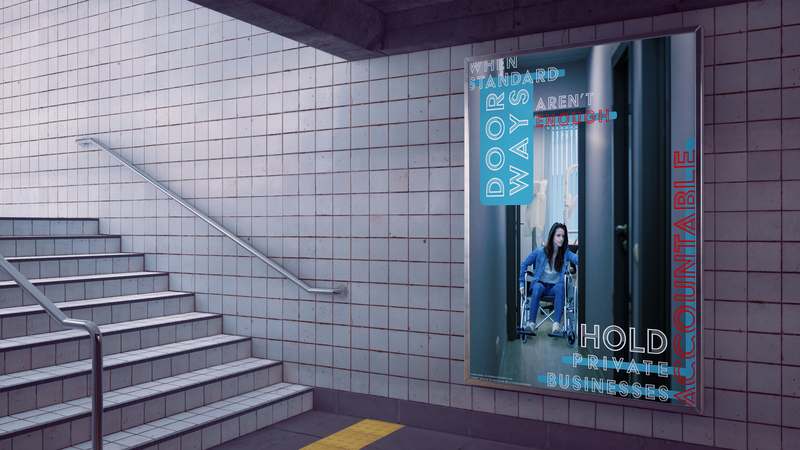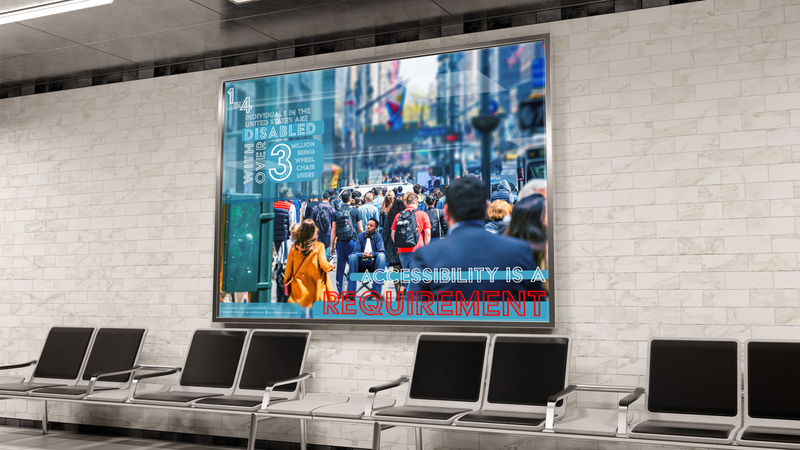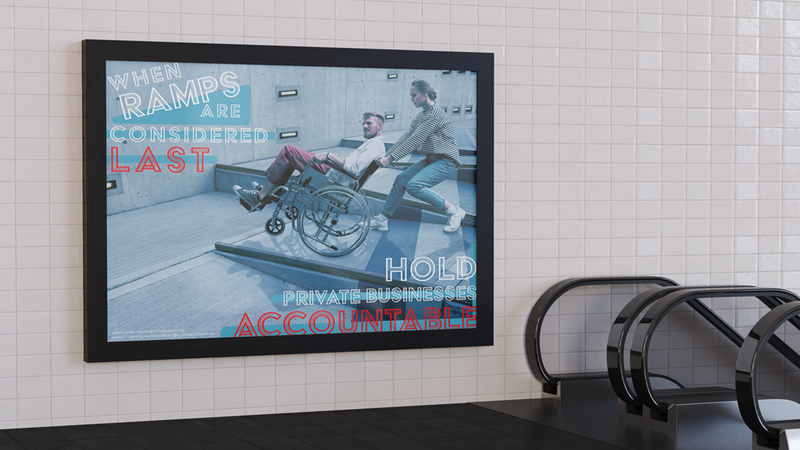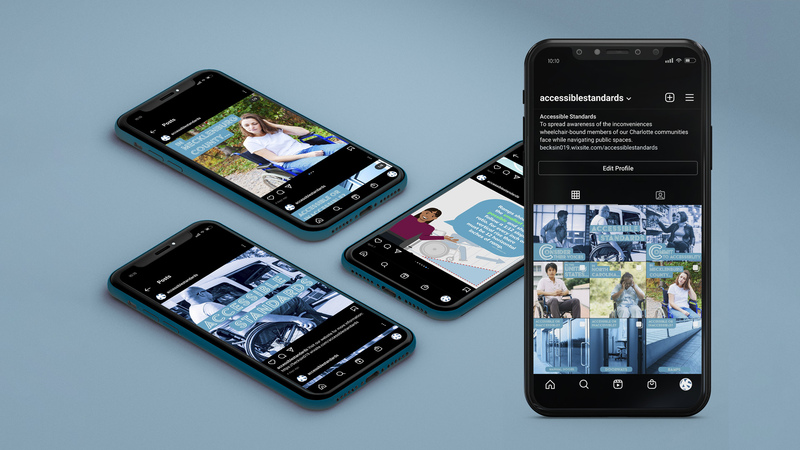Accessible Standards -Sinise Beckett
Thesis Abstract
One in four individuals in the United States are disabled, totaling approximately sixty-four million Americans—with over three million being wheelchair users. Despite having such a large population and demand for accommodations for them, it seems that it often takes a back seat in the list of priorities when designing public spaces. Private businesses are especially notorious for this oversight. The reality for many in this community is that simply going out in public can be a hardship. The introduction of the Americans with Disabilities Act of 1990(ADA) sought to tackle discrimination based on a person’s disabilities, but it simply does not do enough on its own to enforce more widespread accessibility. Extra consideration and finances are required in order to follow these rules, with the latter arguably being the biggest motivator against properly adhering to these standards.
Without proper awareness and enforcement of ADA standards, there are gaps in accessibility, which leaves individuals feeling frustrated and unequal. For example, all stepped entrances require a ramp. However, these are often too steep, making it inaccessible for those manually operating their wheelchairs. Opening a door from a wheelchair is a struggle, and doors and entryways are often too narrow to squeeze through. Automated doorways are not required for private establishments, leaving people to have to fight to open both the door and navigate their chairs into the door at the same time. These are only a small percentage of the challenges often faced by disabled individuals while trying to carry out simple tasks in public spaces.
Therefore, with my thesis project, I hope to spread awareness of the obstacles wheelchair-bound individuals face while trying to live out their lives. My goal is to make this problem more well known to the general public, and to inspire private businesses and establishments to better accommodate all their customers and guests. My thesis project will include the creation of three products to complete these goals. These products will include a website that will seek to educate and demonstrate inaccessible spaces and how they can be improved. To promote this website, I will also create a social media campaign through Instagram and put up a series of posters that will be hung in community bulletin boards, subway, and train stations.
From Thesis Abstract by Sinise Beckett
Project Mockups
Interview with the Artist
Motivation for the Project:
It tackles accessibility in public spaces and the poor and lack of proper compliance to ADA standards. ADA standards were put in place to make sure disabled individuals are able to access and experience public spaces and businesses without much hassle. However, inaccessibility is still a widespread problem in our communities and with my project, I wanted to bring attention to this issue. The project involved interviewing members of this community and creating a campaign to help spread information to the general public through posters, a website, and a series of infographics presented through Instagram. The inspiration for this project developed through my own personal experience navigating these spaces with my older sister. She is totally disabled and uses a wheelchair. Throughout the years of going out to various businesses, we’ve run into many situations where it became hard to enter businesses because of inaccessibility. Whether that be ramps that were too steep, doors that were too narrow, etc. If it was hard for us, imagine how difficult it is for independent disabled persons that have to visit these places everyday. Accessibility is a right and we should be pushing for accessibility for all. If you would like to learn more, please visit my website and my Instagram page: @accessiblestandards.
QUESTIONS
What drew you to wheelchair users for accessibility?
My sister is totally disabled and uses a wheelchair to get around, so I have experienced wheelchair inaccessibility personally through my family and I helping her.
How did you choose the places to put the posters?
I focused on common occurrences of lack of proper ADA compliance, such has doorways and ramps.
What kind of research did you do to understand the needs of wheelchair users?
My research for this project included looking through documented ADA requirements for North Carolina, reading through articles and social spaces that discussed inaccessibility. I also personally reached out to organizations that work with the disabled and was connected with disabled individuals where I listened to their personal accounts on the subject and grievances with the challenges they’ve faced due to inaccessibility.
What were some common issues with private buildings that you found in your research?
As mentioned before, the doorways being too narrow to fit a wheelchair through and/or manual doors that are hard to open with one hand. Manual doors can be too heavy for a person to pull open with one hand, as many wheelchair users use a manual/self-propelled wheelchair. However, automatic doors are one of the best ways to be accessible. Another common issue are ramps that are too steep. This can be caused because of poor planning and considering ramps last. Trying to fit ramps in small spaces means making them steeper, which makes it very difficult for a wheelchair-bound person to pull themselves up it.
Do you have a goal in mind of the impact that you would like your work to have?
I would like for my work to reach the general public to educate them on the inaccessibility many of their fellow Americans face. When awareness is spread, I’m hoping that it sparks a conversation that will lead to action. I hope that it will lead to pushes to hold businesses accountable for their poor or lack of compliance. The disabled community have and continue to fight for these rights, and they need all the voices they can in order to keep moving forward.
Relevant Books
Accessible Buildings and Other Structures
American National Standard : Accessible and Usable Buildings and Facilities. 2003 ed., The Council, 2004.
Accessible and Usable Buildings and Facilities : ICC A117.1-2009 : American National Standard. International Code Council, 2010.
ADA and City Governments : Common Problems. U.S. Dept. of Justice, Civil Rights Division, Disability Rights Section, 2000.
Meuser, Philipp. Accessible Architecture. Second revised edition., DOM Publishers, 2012.
Pullin, Graham. Design Meets Disability. MIT Press, 2009.
Wheelchair Accessibility and Use
Džafić, Dženan, et al. “eNav: A Suitable Navigation System for the Disabled.” Ambient Assisted Living, Springer International Publishing, 2017, pp. 133–50, https://doi.org/10.1007/978-3-319-52322-4_9.
Fleischer, Doris Zames., and Frieda Zames. The Disability Rights Movement : from Charity to Confrontation. Temple University Press, 2001.
Gharebaghi, Amin, et al. “A Confidence-Based Approach for the Assessment of Accessibility of Pedestrian Network for Manual Wheelchair Users.” Advances in Cartography and GIScience, Springer International Publishing, 2017, pp. 463–77, https://doi.org/10.1007/978-3-319-57336-6_32.
Guffey, Elizabeth E. Designing Disability : Symbols, Space, and Society. Bloomsbury Academic, an imprint of Bloomsbury Publishing Plc, 2018.
Improving Access to Taxis. Organisation for Economic Co-operation and Development (OECD), 2007.
Smith, Korydon H., and Wolfgang F. E. Preiser. Universal Design Handbook. 2nd ed., McGraw-Hill, 2011.
Silva, Beatriz, et al. “Development Gestural Interface for Motorized Wheelchair Control.” Advances in Physical Ergonomics and Human Factors, Springer International Publishing, 2016, pp. 773–82, https://doi.org/10.1007/978-3-319-41694-6_74.
Assistive Techology
Anson, Denis K. Assistive Technology for People with Disabilities. ABC-CLIO, LLC, 2018.
Green, Joan L. Assistive Technology in Special Education : Resources to Support Literacy, Communication, and Learning Differences. Third edition., Prufrock Press, Inc., 2018.
Ravneberg, Bodil, and Sylvia Söderström. Disability, Society and Assistive Technology. Routledge, Taylor & Francis Group, 2017.
Disabilities Sourcebook : Basic Consumer Health Information About Disabilities That Affect the Body, Mind, and Senses, Including Birth Defects, Hearing and Vision Loss, Speech Disorders, Learning Disabilities, Psychiatric Disorders, Degenerative Diseases, and Disabilities Caused by Injury and Trauma, Such as Amputation, Spinal Cord Injury, and Traumatic Brain Injury ; Along with Facts About Assistive Technology, Physical and Occupational Therapy, Maintaining Health and Wellness, Special Education, Legal, Financial, Education, and Insurance Issues, a Glossary of Related Terms, and Resources for Additional Help and Information. Fourth edition., OMNIGRAPHICS, 2018.






